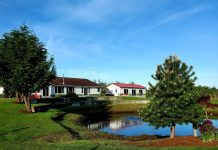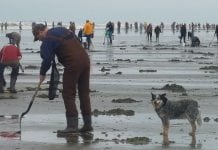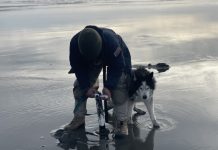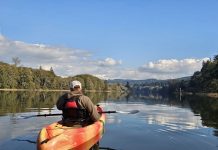This calendar is the place to find fun events happening throughout Grays Harbor County including Aberdeen, Hoquiam, Westport, Ocean Shores, Elma, Montesano and beyond.
Have an event that isn’t listed? Please email events@GraysHarborTalk.com with the following information:
- Name of Event
- Date, time and location (name of business if applicable and complete address)
- Organizer(s) name
- Cost
- URL to purchase tickets
- Website URL
- SHORT description of event
- Photo
Our editors will review and post within a few business days.
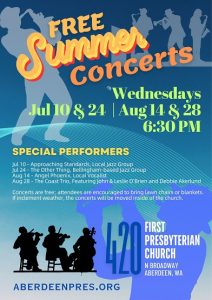
First Presbyterian Church of Aberdeen will hold four concerts this summer as part of our summer lawn concert series. The performances will be held Wednesday, July 10, July 24, August 14, and August 28 at 6:30 PM.
Performers for the series will include:
Jul 10 – Approaching Standards, Local Jazz Group
Jul 24 – The Other Thing, Bellingham-based Jazz Group
Aug 14 – Angel Phoenix, Local Vocalist
Aug 28 – The Coast Trio, Featuring John & Leslie O’Brien and Debbie Akerlund
Concerts are free; attendees are encouraged to bring lawn chairs or blankets. If inclement weather, the concerts will be moved inside of the church.
First Presbyterian Church of Aberdeen is located at 420 N Broadway, Aberdeen, WA 98520. For more info, go to our web site at www.aberdeenpres.org.

First Presbyterian Church of Aberdeen will hold four concerts this summer as part of our summer lawn concert series. The performances will be held Wednesday, July 10, July 24, August 14, and August 28 at 6:30 PM.
Performers for the series will include:
Jul 10 – Approaching Standards, Local Jazz Group
Jul 24 – The Other Thing, Bellingham-based Jazz Group
Aug 14 – Angel Phoenix, Local Vocalist
Aug 28 – The Coast Trio, Featuring John & Leslie O’Brien and Debbie Akerlund
Concerts are free; attendees are encouraged to bring lawn chairs or blankets. If inclement weather, the concerts will be moved inside of the church.
First Presbyterian Church of Aberdeen is located at 420 N Broadway, Aberdeen, WA 98520. For more info, go to our web site at www.aberdeenpres.org.
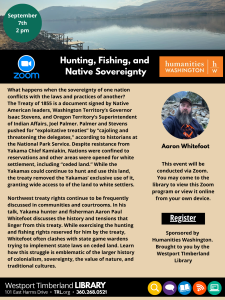
Humanities Washington Speaker Event:
Hunting, Fishing, and Native Sovereignty-Aaron Whitefoot
What happens when the sovereignty of one nation conflicts with the laws and practices of another?
The Treaty of 1855 is a document signed by Native American leaders, Washington Territory’s Governor Isaac Stevens, and Oregon Territory’s Superintendent of Indian Affairs, Joel Palmer. Palmer and Stevens pushed for “exploitative treaties” by “cajoling and threatening the delegates,” according to historians at the National Park Service. Despite resistance from Yakama Chief Kamiakin, Nations were confined to reservations and other areas were opened for white settlement, including “ceded land.” While the Yakamas could continue to hunt and use this land, the treaty removed the Yakamas’ exclusive use of it, granting wide access to of the land to white settlers.
Northwest treaty rights continue to be frequently discussed in communities and courtrooms. In his talk, Yakama hunter and fisherman Aaron Paul Whitefoot discusses the history and tensions that linger from this treaty. While exercising the hunting and fishing rights reserved for him by the treaty, Whitefoot often clashes with state game wardens trying to implement state laws on ceded land. Learn how this struggle is emblematic of the larger history of colonialism, sovereignty, the value of nature, and traditional cultures.

Humanities Washington Speaker Event:
Race, Gender, and Monsters: What Vampires and Werewolves Reveal About Ourselves and Our Culture- Bernadette Calafell
Why do some monsters seem to resonate through time?
What do they say about our social and cultural anxieties around difference—in particular race, class, gender, sexuality, nationality, and ability?
This talk explores the shifting meanings vampires and werewolves have taken in popular culture, with a particular focus on the 1980s through the 2000s. In addition, these figures will be compared to the early Universal horror film monsters Dracula and The Wolf Man. Discover how the monsters we love tell us a great deal about ourselves and our changing cultural ideas about difference.
“It was a great first tide series of the season last week (Oct. 3-7) with soft wind, calm waves, and dry skies that resulted in mostly limits for those that came out,” said Bryce Blumenthal, a WDFW coastal shellfish biologist. “We are hoping this next tide series will bring similar success with lower and earlier tides that should allow for daylight digging opportunity the first few days.”
In early fall the beaches still have a lot of sand built up, which can make beach driving hazardous. WDFW asks diggers to drive carefully on the uppermost part of the hard-packed sand, avoid wet sand and not to create congestion leading on and off the beach by parking on the approaches.
The Washington Department of Health (DOH) requires test samples for marine toxins, and domoic acid levels must fall under the guideline level before a beach can open for digging. Domoic acid, a natural toxin produced by certain types of marine algae, can be harmful or fatal if consumed in sufficient quantities. Final approval usually occurs about a week or less – sometimes two to three days – before the start of each digging series. More information about domoic acid, as well as current levels at ocean beaches, can be found on the WDFW’s domoic acid webpage.
The following digs during evening (p.m.) low tides will proceed as scheduled, after marine toxin results from the DOH showed razor clams are safe to eat:
- Oct. 15, Tuesday, 5:31 p.m.; 0.5 feet; Long Beach, Twin Harbors, Mocrocks
- Oct. 16, Wednesday, 6:18 p.m.; -0.5 feet; Long Beach, Twin Harbors, Copalis
- Oct. 17, Thursday, 7:03 p.m.; -1.3 feet; Long Beach, Twin Harbors, Copalis
- Oct. 18, Friday, 7:49 p.m.; -1.7 feet; Long Beach, Twin Harbors, Mocrocks
- Oct. 19, Saturday, 8:35 p.m.; -1.7 feet; Long Beach, Twin Harbors, Mocrocks
- Oct. 20, Sunday, 9:24 p.m.; -1.4 feet; Long Beach, Twin Harbors, Copalis
- Oct. 21, Monday, 10:16 p.m.; -0.8 feet; Long Beach, Twin Harbors, Copalis
“It was a great first tide series of the season last week (Oct. 3-7) with soft wind, calm waves, and dry skies that resulted in mostly limits for those that came out,” said Bryce Blumenthal, a WDFW coastal shellfish biologist. “We are hoping this next tide series will bring similar success with lower and earlier tides that should allow for daylight digging opportunity the first few days.”
In early fall the beaches still have a lot of sand built up, which can make beach driving hazardous. WDFW asks diggers to drive carefully on the uppermost part of the hard-packed sand, avoid wet sand and not to create congestion leading on and off the beach by parking on the approaches.
The Washington Department of Health (DOH) requires test samples for marine toxins, and domoic acid levels must fall under the guideline level before a beach can open for digging. Domoic acid, a natural toxin produced by certain types of marine algae, can be harmful or fatal if consumed in sufficient quantities. Final approval usually occurs about a week or less – sometimes two to three days – before the start of each digging series. More information about domoic acid, as well as current levels at ocean beaches, can be found on the WDFW’s domoic acid webpage.
The following digs during evening (p.m.) low tides will proceed as scheduled, after marine toxin results from the DOH showed razor clams are safe to eat:
- Oct. 15, Tuesday, 5:31 p.m.; 0.5 feet; Long Beach, Twin Harbors, Mocrocks
- Oct. 16, Wednesday, 6:18 p.m.; -0.5 feet; Long Beach, Twin Harbors, Copalis
- Oct. 17, Thursday, 7:03 p.m.; -1.3 feet; Long Beach, Twin Harbors, Copalis
- Oct. 18, Friday, 7:49 p.m.; -1.7 feet; Long Beach, Twin Harbors, Mocrocks
- Oct. 19, Saturday, 8:35 p.m.; -1.7 feet; Long Beach, Twin Harbors, Mocrocks
- Oct. 20, Sunday, 9:24 p.m.; -1.4 feet; Long Beach, Twin Harbors, Copalis
- Oct. 21, Monday, 10:16 p.m.; -0.8 feet; Long Beach, Twin Harbors, Copalis
“It was a great first tide series of the season last week (Oct. 3-7) with soft wind, calm waves, and dry skies that resulted in mostly limits for those that came out,” said Bryce Blumenthal, a WDFW coastal shellfish biologist. “We are hoping this next tide series will bring similar success with lower and earlier tides that should allow for daylight digging opportunity the first few days.”
In early fall the beaches still have a lot of sand built up, which can make beach driving hazardous. WDFW asks diggers to drive carefully on the uppermost part of the hard-packed sand, avoid wet sand and not to create congestion leading on and off the beach by parking on the approaches.
The Washington Department of Health (DOH) requires test samples for marine toxins, and domoic acid levels must fall under the guideline level before a beach can open for digging. Domoic acid, a natural toxin produced by certain types of marine algae, can be harmful or fatal if consumed in sufficient quantities. Final approval usually occurs about a week or less – sometimes two to three days – before the start of each digging series. More information about domoic acid, as well as current levels at ocean beaches, can be found on the WDFW’s domoic acid webpage.
The following digs during evening (p.m.) low tides will proceed as scheduled, after marine toxin results from the DOH showed razor clams are safe to eat:
- Oct. 15, Tuesday, 5:31 p.m.; 0.5 feet; Long Beach, Twin Harbors, Mocrocks
- Oct. 16, Wednesday, 6:18 p.m.; -0.5 feet; Long Beach, Twin Harbors, Copalis
- Oct. 17, Thursday, 7:03 p.m.; -1.3 feet; Long Beach, Twin Harbors, Copalis
- Oct. 18, Friday, 7:49 p.m.; -1.7 feet; Long Beach, Twin Harbors, Mocrocks
- Oct. 19, Saturday, 8:35 p.m.; -1.7 feet; Long Beach, Twin Harbors, Mocrocks
- Oct. 20, Sunday, 9:24 p.m.; -1.4 feet; Long Beach, Twin Harbors, Copalis
- Oct. 21, Monday, 10:16 p.m.; -0.8 feet; Long Beach, Twin Harbors, Copalis
“It was a great first tide series of the season last week (Oct. 3-7) with soft wind, calm waves, and dry skies that resulted in mostly limits for those that came out,” said Bryce Blumenthal, a WDFW coastal shellfish biologist. “We are hoping this next tide series will bring similar success with lower and earlier tides that should allow for daylight digging opportunity the first few days.”
In early fall the beaches still have a lot of sand built up, which can make beach driving hazardous. WDFW asks diggers to drive carefully on the uppermost part of the hard-packed sand, avoid wet sand and not to create congestion leading on and off the beach by parking on the approaches.
The Washington Department of Health (DOH) requires test samples for marine toxins, and domoic acid levels must fall under the guideline level before a beach can open for digging. Domoic acid, a natural toxin produced by certain types of marine algae, can be harmful or fatal if consumed in sufficient quantities. Final approval usually occurs about a week or less – sometimes two to three days – before the start of each digging series. More information about domoic acid, as well as current levels at ocean beaches, can be found on the WDFW’s domoic acid webpage.
The following digs during evening (p.m.) low tides will proceed as scheduled, after marine toxin results from the DOH showed razor clams are safe to eat:
- Oct. 15, Tuesday, 5:31 p.m.; 0.5 feet; Long Beach, Twin Harbors, Mocrocks
- Oct. 16, Wednesday, 6:18 p.m.; -0.5 feet; Long Beach, Twin Harbors, Copalis
- Oct. 17, Thursday, 7:03 p.m.; -1.3 feet; Long Beach, Twin Harbors, Copalis
- Oct. 18, Friday, 7:49 p.m.; -1.7 feet; Long Beach, Twin Harbors, Mocrocks
- Oct. 19, Saturday, 8:35 p.m.; -1.7 feet; Long Beach, Twin Harbors, Mocrocks
- Oct. 20, Sunday, 9:24 p.m.; -1.4 feet; Long Beach, Twin Harbors, Copalis
- Oct. 21, Monday, 10:16 p.m.; -0.8 feet; Long Beach, Twin Harbors, Copalis
“It was a great first tide series of the season last week (Oct. 3-7) with soft wind, calm waves, and dry skies that resulted in mostly limits for those that came out,” said Bryce Blumenthal, a WDFW coastal shellfish biologist. “We are hoping this next tide series will bring similar success with lower and earlier tides that should allow for daylight digging opportunity the first few days.”
In early fall the beaches still have a lot of sand built up, which can make beach driving hazardous. WDFW asks diggers to drive carefully on the uppermost part of the hard-packed sand, avoid wet sand and not to create congestion leading on and off the beach by parking on the approaches.
The Washington Department of Health (DOH) requires test samples for marine toxins, and domoic acid levels must fall under the guideline level before a beach can open for digging. Domoic acid, a natural toxin produced by certain types of marine algae, can be harmful or fatal if consumed in sufficient quantities. Final approval usually occurs about a week or less – sometimes two to three days – before the start of each digging series. More information about domoic acid, as well as current levels at ocean beaches, can be found on the WDFW’s domoic acid webpage.
The following digs during evening (p.m.) low tides will proceed as scheduled, after marine toxin results from the DOH showed razor clams are safe to eat:
- Oct. 15, Tuesday, 5:31 p.m.; 0.5 feet; Long Beach, Twin Harbors, Mocrocks
- Oct. 16, Wednesday, 6:18 p.m.; -0.5 feet; Long Beach, Twin Harbors, Copalis
- Oct. 17, Thursday, 7:03 p.m.; -1.3 feet; Long Beach, Twin Harbors, Copalis
- Oct. 18, Friday, 7:49 p.m.; -1.7 feet; Long Beach, Twin Harbors, Mocrocks
- Oct. 19, Saturday, 8:35 p.m.; -1.7 feet; Long Beach, Twin Harbors, Mocrocks
- Oct. 20, Sunday, 9:24 p.m.; -1.4 feet; Long Beach, Twin Harbors, Copalis
- Oct. 21, Monday, 10:16 p.m.; -0.8 feet; Long Beach, Twin Harbors, Copalis
“It was a great first tide series of the season last week (Oct. 3-7) with soft wind, calm waves, and dry skies that resulted in mostly limits for those that came out,” said Bryce Blumenthal, a WDFW coastal shellfish biologist. “We are hoping this next tide series will bring similar success with lower and earlier tides that should allow for daylight digging opportunity the first few days.”
In early fall the beaches still have a lot of sand built up, which can make beach driving hazardous. WDFW asks diggers to drive carefully on the uppermost part of the hard-packed sand, avoid wet sand and not to create congestion leading on and off the beach by parking on the approaches.
The Washington Department of Health (DOH) requires test samples for marine toxins, and domoic acid levels must fall under the guideline level before a beach can open for digging. Domoic acid, a natural toxin produced by certain types of marine algae, can be harmful or fatal if consumed in sufficient quantities. Final approval usually occurs about a week or less – sometimes two to three days – before the start of each digging series. More information about domoic acid, as well as current levels at ocean beaches, can be found on the WDFW’s domoic acid webpage.
The following digs during evening (p.m.) low tides will proceed as scheduled, after marine toxin results from the DOH showed razor clams are safe to eat:
- Oct. 15, Tuesday, 5:31 p.m.; 0.5 feet; Long Beach, Twin Harbors, Mocrocks
- Oct. 16, Wednesday, 6:18 p.m.; -0.5 feet; Long Beach, Twin Harbors, Copalis
- Oct. 17, Thursday, 7:03 p.m.; -1.3 feet; Long Beach, Twin Harbors, Copalis
- Oct. 18, Friday, 7:49 p.m.; -1.7 feet; Long Beach, Twin Harbors, Mocrocks
- Oct. 19, Saturday, 8:35 p.m.; -1.7 feet; Long Beach, Twin Harbors, Mocrocks
- Oct. 20, Sunday, 9:24 p.m.; -1.4 feet; Long Beach, Twin Harbors, Copalis
- Oct. 21, Monday, 10:16 p.m.; -0.8 feet; Long Beach, Twin Harbors, Copalis
“It was a great first tide series of the season last week (Oct. 3-7) with soft wind, calm waves, and dry skies that resulted in mostly limits for those that came out,” said Bryce Blumenthal, a WDFW coastal shellfish biologist. “We are hoping this next tide series will bring similar success with lower and earlier tides that should allow for daylight digging opportunity the first few days.”
In early fall the beaches still have a lot of sand built up, which can make beach driving hazardous. WDFW asks diggers to drive carefully on the uppermost part of the hard-packed sand, avoid wet sand and not to create congestion leading on and off the beach by parking on the approaches.
The Washington Department of Health (DOH) requires test samples for marine toxins, and domoic acid levels must fall under the guideline level before a beach can open for digging. Domoic acid, a natural toxin produced by certain types of marine algae, can be harmful or fatal if consumed in sufficient quantities. Final approval usually occurs about a week or less – sometimes two to three days – before the start of each digging series. More information about domoic acid, as well as current levels at ocean beaches, can be found on the WDFW’s domoic acid webpage.
The following digs during evening (p.m.) low tides will proceed as scheduled, after marine toxin results from the DOH showed razor clams are safe to eat:
- Oct. 15, Tuesday, 5:31 p.m.; 0.5 feet; Long Beach, Twin Harbors, Mocrocks
- Oct. 16, Wednesday, 6:18 p.m.; -0.5 feet; Long Beach, Twin Harbors, Copalis
- Oct. 17, Thursday, 7:03 p.m.; -1.3 feet; Long Beach, Twin Harbors, Copalis
- Oct. 18, Friday, 7:49 p.m.; -1.7 feet; Long Beach, Twin Harbors, Mocrocks
- Oct. 19, Saturday, 8:35 p.m.; -1.7 feet; Long Beach, Twin Harbors, Mocrocks
- Oct. 20, Sunday, 9:24 p.m.; -1.4 feet; Long Beach, Twin Harbors, Copalis
- Oct. 21, Monday, 10:16 p.m.; -0.8 feet; Long Beach, Twin Harbors, Copalis

2nd seating time added due to demand! 8:00 PM-10:00 PM
Each performance will be unique so guests who sit down for the second performance don’t have to worry about spoilers!
Celebrate spooky season in the dark northwest forests by solving a murder mystery at the Lake Quinault Lodge. Come dressed in your best 1920s costume, enjoy a premium buffet dinner from the Roosevelt Room, and flout prohibition with cocktails and other drinks. Anticipate mystery, hijinks, and maybe even a haunting. Anything can happen out here.
All costumes are welcome. There will be a prize for the best dressed.
November will kick off with razor clam digging opportunities on four coastal beaches, Washington Department of Fish and Wildlife (WDFW) shellfish managers confirmed today.
“Our first fall storm arrived this past weekend, but that didn’t stop diggers from braving the elements and trying to get a limit,” said Bryce Blumenthal, WDFW’s recreational razor clam manager, “Hopefully the weather gives us a break for this next tide series from Nov. 1-5.”
The Washington Department of Health (DOH) requires testing of razor clam samples for marine toxins, and domoic acid levels must fall under the guideline level before a beach can open for digging. Domoic acid, a natural toxin produced by certain types of marine algae, can be harmful or fatal if consumed in sufficient quantities. Final approval usually occurs a few days to a week before the start of each dig series. More information about domoic acid, as well as current levels at ocean beaches, can be found on WDFW’s domoic acid webpage.
The following digs during evening (p.m.) low tides will proceed as scheduled, after marine toxin results from DOH showed razor clams are safe to eat:
- Nov 1, Friday, 7:15 p.m.; -0.2 feet; Long Beach, Twin Harbors, Mocrocks
- Nov 2, Saturday, 7:47 p.m.; -0.4 feet; Long Beach, Twin Harbors, Mocrocks (switch to standard time)
- Nov 3, Sunday, 7:22 p.m.; -0.4 feet; Long Beach, Twin Harbors, Copalis
- Nov 4, Monday, 8 p.m.; -0.3 feet; Long Beach, Twin Harbors, Copalis
- Nov 5, Tuesday, 8:42 p.m.; -0.1 feet; Long Beach, Twin Harbors, Mocrocks
Below are additional tentative dates:
- Nov 13, Wednesday, 4:15 p.m.; -0.2 feet; Long Beach, Twin Harbors, Mocrocks
- Nov 14, Thursday, 5:02 p.m.; -1.1 feet; Long Beach, Twin Harbors, Mocrocks
- Nov 15, Friday, 5:48 p.m.; -1.7 feet; Long Beach, Twin Harbors, Copalis
- Nov 16, Saturday, 6:33 p.m.; -1.9 feet; Long Beach, Twin Harbors, Copalis
- Nov 17, Sunday, 7:19 p.m.; -1.8 feet; Long Beach, Twin Harbors, Mocrocks
- Nov 18, Monday, 8:05 p.m.; -1.3 feet; Long Beach, Twin Harbors, Mocrocks
- Nov 19, Tuesday, 8:54 p.m.; -0.7 feet; Long Beach, Twin Harbors, Copalis
- Nov 29, Friday, 5:20 p.m.; -0.1 feet; Long Beach, Twin Harbors, Mocrocks
- Nov 30, Saturday, 5:54 p.m.; -0.4 feet; Long Beach, Twin Harbors, Mocrocks
- Dec 1, Sunday, 6:30 p.m.; -0.6 feet; Long Beach, Twin Harbors, Copalis
- Dec 2, Monday, 7:06 p.m.; -0.7 feet; Long Beach, Twin Harbors, Copalis
- Dec 3, Tuesday, 7:46 p.m.; -0.6 feet; Long Beach, Twin Harbors, Mocrocks
- Dec 4, Wednesday, 8:28 p.m.; -0.5 feet; Long Beach, Twin Harbors, Mocrocks
- Dec 5, Thursday, 9:13 p.m.; -0.2 feet; Long Beach, Twin Harbors, Copalis
- Dec 12, Thursday, 4 p.m.; -0.5 feet; Long Beach, Twin Harbors, Copalis
- Dec 13, Friday, 4:50 p.m.; -1.2 feet; Long Beach, Twin Harbors, Mocrocks
- Dec 14, Saturday, 5:36 p.m.; -1.6 feet; Long Beach, Twin Harbors, Mocrocks
- Dec 15, Sunday, 6:21 p.m.; -1.6 feet; Long Beach, Twin Harbors, Copalis
- Dec 16, Monday, 7:05 p.m.; -1.5 feet; Long Beach, Twin Harbors, Copalis
- Dec 17, Tuesday, 7:48 p.m.; -1.1 feet; Long Beach, Twin Harbors, Mocrocks
- Dec 18, Wednesday, 8:31 p.m.; -0.5 feet; Long Beach, Twin Harbors, Mocrocks
- Dec 28, Saturday, 4:58 p.m.; 0.0 feet; Long Beach, Twin Harbors, Copalis
- Dec 29, Sunday, 5:36 p.m.; -0.4 feet; Long Beach, Twin Harbors, Mocrocks
- Dec 30, Monday, 6:14 p.m.; -0.7 feet; Long Beach, Twin Harbors, Mocrocks
- Dec 31, Tuesday, 6:51 p.m.; -1.0 feet; Long Beach, Twin Harbors, Copalis
No digging is allowed before noon during digs when low tide occurs in the afternoon or evening. Most successful digging occurs between one and two hours before the listed time of low tide.
In fall beaches still have a lot of sand built up, which can make driving hazardous. WDFW asks diggers to drive carefully on the uppermost part of the hard-packed sand, avoid wet sand, and not to create congestion leading on and off the beach by parking on the approaches.
All diggers 15 or older must have an applicable fishing license to harvest razor clams on any beach. Licenses can be purchased from WDFW’s licensing website, and from hundreds of license vendors around the state. WDFW recommends buying your license before visiting coastal beach communities.
The 2024-25 Razor Clam Management Plan is available on WDFW’s razor clam webpage.
The Washington Department of Fish and Wildlife works to preserve, protect, and perpetuate fish, wildlife and ecosystems while providing sustainable fish and wildlife recreational and commercial opportunities.
November will kick off with razor clam digging opportunities on four coastal beaches, Washington Department of Fish and Wildlife (WDFW) shellfish managers confirmed today.
“Our first fall storm arrived this past weekend, but that didn’t stop diggers from braving the elements and trying to get a limit,” said Bryce Blumenthal, WDFW’s recreational razor clam manager, “Hopefully the weather gives us a break for this next tide series from Nov. 1-5.”
The Washington Department of Health (DOH) requires testing of razor clam samples for marine toxins, and domoic acid levels must fall under the guideline level before a beach can open for digging. Domoic acid, a natural toxin produced by certain types of marine algae, can be harmful or fatal if consumed in sufficient quantities. Final approval usually occurs a few days to a week before the start of each dig series. More information about domoic acid, as well as current levels at ocean beaches, can be found on WDFW’s domoic acid webpage.
The following digs during evening (p.m.) low tides will proceed as scheduled, after marine toxin results from DOH showed razor clams are safe to eat:
- Nov 1, Friday, 7:15 p.m.; -0.2 feet; Long Beach, Twin Harbors, Mocrocks
- Nov 2, Saturday, 7:47 p.m.; -0.4 feet; Long Beach, Twin Harbors, Mocrocks (switch to standard time)
- Nov 3, Sunday, 7:22 p.m.; -0.4 feet; Long Beach, Twin Harbors, Copalis
- Nov 4, Monday, 8 p.m.; -0.3 feet; Long Beach, Twin Harbors, Copalis
- Nov 5, Tuesday, 8:42 p.m.; -0.1 feet; Long Beach, Twin Harbors, Mocrocks
Below are additional tentative dates:
- Nov 13, Wednesday, 4:15 p.m.; -0.2 feet; Long Beach, Twin Harbors, Mocrocks
- Nov 14, Thursday, 5:02 p.m.; -1.1 feet; Long Beach, Twin Harbors, Mocrocks
- Nov 15, Friday, 5:48 p.m.; -1.7 feet; Long Beach, Twin Harbors, Copalis
- Nov 16, Saturday, 6:33 p.m.; -1.9 feet; Long Beach, Twin Harbors, Copalis
- Nov 17, Sunday, 7:19 p.m.; -1.8 feet; Long Beach, Twin Harbors, Mocrocks
- Nov 18, Monday, 8:05 p.m.; -1.3 feet; Long Beach, Twin Harbors, Mocrocks
- Nov 19, Tuesday, 8:54 p.m.; -0.7 feet; Long Beach, Twin Harbors, Copalis
- Nov 29, Friday, 5:20 p.m.; -0.1 feet; Long Beach, Twin Harbors, Mocrocks
- Nov 30, Saturday, 5:54 p.m.; -0.4 feet; Long Beach, Twin Harbors, Mocrocks
- Dec 1, Sunday, 6:30 p.m.; -0.6 feet; Long Beach, Twin Harbors, Copalis
- Dec 2, Monday, 7:06 p.m.; -0.7 feet; Long Beach, Twin Harbors, Copalis
- Dec 3, Tuesday, 7:46 p.m.; -0.6 feet; Long Beach, Twin Harbors, Mocrocks
- Dec 4, Wednesday, 8:28 p.m.; -0.5 feet; Long Beach, Twin Harbors, Mocrocks
- Dec 5, Thursday, 9:13 p.m.; -0.2 feet; Long Beach, Twin Harbors, Copalis
- Dec 12, Thursday, 4 p.m.; -0.5 feet; Long Beach, Twin Harbors, Copalis
- Dec 13, Friday, 4:50 p.m.; -1.2 feet; Long Beach, Twin Harbors, Mocrocks
- Dec 14, Saturday, 5:36 p.m.; -1.6 feet; Long Beach, Twin Harbors, Mocrocks
- Dec 15, Sunday, 6:21 p.m.; -1.6 feet; Long Beach, Twin Harbors, Copalis
- Dec 16, Monday, 7:05 p.m.; -1.5 feet; Long Beach, Twin Harbors, Copalis
- Dec 17, Tuesday, 7:48 p.m.; -1.1 feet; Long Beach, Twin Harbors, Mocrocks
- Dec 18, Wednesday, 8:31 p.m.; -0.5 feet; Long Beach, Twin Harbors, Mocrocks
- Dec 28, Saturday, 4:58 p.m.; 0.0 feet; Long Beach, Twin Harbors, Copalis
- Dec 29, Sunday, 5:36 p.m.; -0.4 feet; Long Beach, Twin Harbors, Mocrocks
- Dec 30, Monday, 6:14 p.m.; -0.7 feet; Long Beach, Twin Harbors, Mocrocks
- Dec 31, Tuesday, 6:51 p.m.; -1.0 feet; Long Beach, Twin Harbors, Copalis
No digging is allowed before noon during digs when low tide occurs in the afternoon or evening. Most successful digging occurs between one and two hours before the listed time of low tide.
In fall beaches still have a lot of sand built up, which can make driving hazardous. WDFW asks diggers to drive carefully on the uppermost part of the hard-packed sand, avoid wet sand, and not to create congestion leading on and off the beach by parking on the approaches.
All diggers 15 or older must have an applicable fishing license to harvest razor clams on any beach. Licenses can be purchased from WDFW’s licensing website, and from hundreds of license vendors around the state. WDFW recommends buying your license before visiting coastal beach communities.
The 2024-25 Razor Clam Management Plan is available on WDFW’s razor clam webpage.
The Washington Department of Fish and Wildlife works to preserve, protect, and perpetuate fish, wildlife and ecosystems while providing sustainable fish and wildlife recreational and commercial opportunities.
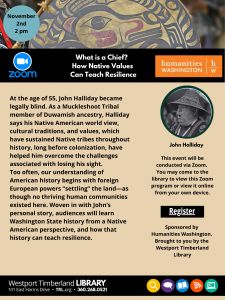
Humanities Washington Speaker Event:
What is a Chief? How native Values Can Teach Resilience-John Halliday
Most museums display no more than 10 percent of their holdings, often citing “not enough space” as the reason. But there are also a wide range of cultural, philosophical, political, environmental, historic, and even superstitious reasons why museums keep some objects from public view.
In this talk, explore a wide range of hidden objects found in the back rooms of museums in our state and around the country. Examples include a Spokane institution that holds Bing Crosby’s toupées and a museum in Lynden that’s home to a 150-year-old pickle. When possible, we will have local museum curators on hand to answer questions, participate in our discussions, and unbox a few hidden treasures.

As part of First Presbyterian Church of Aberdeen’s mission to the community, our church will hold a spaghetti dinner and craft fair on Saturday, November 2 nd from 5:00-7:00 pm. Funds raised will be used to purchase stocking caps, socks and gloves for those in need. The dinner will include spaghetti, salad, bread, dessert, and beverage. Vegetarian & Gluten Free options are available. The cost is $10 for adults and $7 for children 12 and under. Crafts for the event are being made and donated by the congregation.
Tickets can be purchased at the church office or at the door the day of the event.
There is no cost to attend the craft fair. For more information, visit our website at aberdeenpres.org.
November will kick off with razor clam digging opportunities on four coastal beaches, Washington Department of Fish and Wildlife (WDFW) shellfish managers confirmed today.
“Our first fall storm arrived this past weekend, but that didn’t stop diggers from braving the elements and trying to get a limit,” said Bryce Blumenthal, WDFW’s recreational razor clam manager, “Hopefully the weather gives us a break for this next tide series from Nov. 1-5.”
The Washington Department of Health (DOH) requires testing of razor clam samples for marine toxins, and domoic acid levels must fall under the guideline level before a beach can open for digging. Domoic acid, a natural toxin produced by certain types of marine algae, can be harmful or fatal if consumed in sufficient quantities. Final approval usually occurs a few days to a week before the start of each dig series. More information about domoic acid, as well as current levels at ocean beaches, can be found on WDFW’s domoic acid webpage.
The following digs during evening (p.m.) low tides will proceed as scheduled, after marine toxin results from DOH showed razor clams are safe to eat:
- Nov 1, Friday, 7:15 p.m.; -0.2 feet; Long Beach, Twin Harbors, Mocrocks
- Nov 2, Saturday, 7:47 p.m.; -0.4 feet; Long Beach, Twin Harbors, Mocrocks (switch to standard time)
- Nov 3, Sunday, 7:22 p.m.; -0.4 feet; Long Beach, Twin Harbors, Copalis
- Nov 4, Monday, 8 p.m.; -0.3 feet; Long Beach, Twin Harbors, Copalis
- Nov 5, Tuesday, 8:42 p.m.; -0.1 feet; Long Beach, Twin Harbors, Mocrocks
Below are additional tentative dates:
- Nov 13, Wednesday, 4:15 p.m.; -0.2 feet; Long Beach, Twin Harbors, Mocrocks
- Nov 14, Thursday, 5:02 p.m.; -1.1 feet; Long Beach, Twin Harbors, Mocrocks
- Nov 15, Friday, 5:48 p.m.; -1.7 feet; Long Beach, Twin Harbors, Copalis
- Nov 16, Saturday, 6:33 p.m.; -1.9 feet; Long Beach, Twin Harbors, Copalis
- Nov 17, Sunday, 7:19 p.m.; -1.8 feet; Long Beach, Twin Harbors, Mocrocks
- Nov 18, Monday, 8:05 p.m.; -1.3 feet; Long Beach, Twin Harbors, Mocrocks
- Nov 19, Tuesday, 8:54 p.m.; -0.7 feet; Long Beach, Twin Harbors, Copalis
- Nov 29, Friday, 5:20 p.m.; -0.1 feet; Long Beach, Twin Harbors, Mocrocks
- Nov 30, Saturday, 5:54 p.m.; -0.4 feet; Long Beach, Twin Harbors, Mocrocks
- Dec 1, Sunday, 6:30 p.m.; -0.6 feet; Long Beach, Twin Harbors, Copalis
- Dec 2, Monday, 7:06 p.m.; -0.7 feet; Long Beach, Twin Harbors, Copalis
- Dec 3, Tuesday, 7:46 p.m.; -0.6 feet; Long Beach, Twin Harbors, Mocrocks
- Dec 4, Wednesday, 8:28 p.m.; -0.5 feet; Long Beach, Twin Harbors, Mocrocks
- Dec 5, Thursday, 9:13 p.m.; -0.2 feet; Long Beach, Twin Harbors, Copalis
- Dec 12, Thursday, 4 p.m.; -0.5 feet; Long Beach, Twin Harbors, Copalis
- Dec 13, Friday, 4:50 p.m.; -1.2 feet; Long Beach, Twin Harbors, Mocrocks
- Dec 14, Saturday, 5:36 p.m.; -1.6 feet; Long Beach, Twin Harbors, Mocrocks
- Dec 15, Sunday, 6:21 p.m.; -1.6 feet; Long Beach, Twin Harbors, Copalis
- Dec 16, Monday, 7:05 p.m.; -1.5 feet; Long Beach, Twin Harbors, Copalis
- Dec 17, Tuesday, 7:48 p.m.; -1.1 feet; Long Beach, Twin Harbors, Mocrocks
- Dec 18, Wednesday, 8:31 p.m.; -0.5 feet; Long Beach, Twin Harbors, Mocrocks
- Dec 28, Saturday, 4:58 p.m.; 0.0 feet; Long Beach, Twin Harbors, Copalis
- Dec 29, Sunday, 5:36 p.m.; -0.4 feet; Long Beach, Twin Harbors, Mocrocks
- Dec 30, Monday, 6:14 p.m.; -0.7 feet; Long Beach, Twin Harbors, Mocrocks
- Dec 31, Tuesday, 6:51 p.m.; -1.0 feet; Long Beach, Twin Harbors, Copalis
No digging is allowed before noon during digs when low tide occurs in the afternoon or evening. Most successful digging occurs between one and two hours before the listed time of low tide.
In fall beaches still have a lot of sand built up, which can make driving hazardous. WDFW asks diggers to drive carefully on the uppermost part of the hard-packed sand, avoid wet sand, and not to create congestion leading on and off the beach by parking on the approaches.
All diggers 15 or older must have an applicable fishing license to harvest razor clams on any beach. Licenses can be purchased from WDFW’s licensing website, and from hundreds of license vendors around the state. WDFW recommends buying your license before visiting coastal beach communities.
The 2024-25 Razor Clam Management Plan is available on WDFW’s razor clam webpage.
The Washington Department of Fish and Wildlife works to preserve, protect, and perpetuate fish, wildlife and ecosystems while providing sustainable fish and wildlife recreational and commercial opportunities.
November will kick off with razor clam digging opportunities on four coastal beaches, Washington Department of Fish and Wildlife (WDFW) shellfish managers confirmed today.
“Our first fall storm arrived this past weekend, but that didn’t stop diggers from braving the elements and trying to get a limit,” said Bryce Blumenthal, WDFW’s recreational razor clam manager, “Hopefully the weather gives us a break for this next tide series from Nov. 1-5.”
The Washington Department of Health (DOH) requires testing of razor clam samples for marine toxins, and domoic acid levels must fall under the guideline level before a beach can open for digging. Domoic acid, a natural toxin produced by certain types of marine algae, can be harmful or fatal if consumed in sufficient quantities. Final approval usually occurs a few days to a week before the start of each dig series. More information about domoic acid, as well as current levels at ocean beaches, can be found on WDFW’s domoic acid webpage.
The following digs during evening (p.m.) low tides will proceed as scheduled, after marine toxin results from DOH showed razor clams are safe to eat:
- Nov 1, Friday, 7:15 p.m.; -0.2 feet; Long Beach, Twin Harbors, Mocrocks
- Nov 2, Saturday, 7:47 p.m.; -0.4 feet; Long Beach, Twin Harbors, Mocrocks (switch to standard time)
- Nov 3, Sunday, 7:22 p.m.; -0.4 feet; Long Beach, Twin Harbors, Copalis
- Nov 4, Monday, 8 p.m.; -0.3 feet; Long Beach, Twin Harbors, Copalis
- Nov 5, Tuesday, 8:42 p.m.; -0.1 feet; Long Beach, Twin Harbors, Mocrocks
Below are additional tentative dates:
- Nov 13, Wednesday, 4:15 p.m.; -0.2 feet; Long Beach, Twin Harbors, Mocrocks
- Nov 14, Thursday, 5:02 p.m.; -1.1 feet; Long Beach, Twin Harbors, Mocrocks
- Nov 15, Friday, 5:48 p.m.; -1.7 feet; Long Beach, Twin Harbors, Copalis
- Nov 16, Saturday, 6:33 p.m.; -1.9 feet; Long Beach, Twin Harbors, Copalis
- Nov 17, Sunday, 7:19 p.m.; -1.8 feet; Long Beach, Twin Harbors, Mocrocks
- Nov 18, Monday, 8:05 p.m.; -1.3 feet; Long Beach, Twin Harbors, Mocrocks
- Nov 19, Tuesday, 8:54 p.m.; -0.7 feet; Long Beach, Twin Harbors, Copalis
- Nov 29, Friday, 5:20 p.m.; -0.1 feet; Long Beach, Twin Harbors, Mocrocks
- Nov 30, Saturday, 5:54 p.m.; -0.4 feet; Long Beach, Twin Harbors, Mocrocks
- Dec 1, Sunday, 6:30 p.m.; -0.6 feet; Long Beach, Twin Harbors, Copalis
- Dec 2, Monday, 7:06 p.m.; -0.7 feet; Long Beach, Twin Harbors, Copalis
- Dec 3, Tuesday, 7:46 p.m.; -0.6 feet; Long Beach, Twin Harbors, Mocrocks
- Dec 4, Wednesday, 8:28 p.m.; -0.5 feet; Long Beach, Twin Harbors, Mocrocks
- Dec 5, Thursday, 9:13 p.m.; -0.2 feet; Long Beach, Twin Harbors, Copalis
- Dec 12, Thursday, 4 p.m.; -0.5 feet; Long Beach, Twin Harbors, Copalis
- Dec 13, Friday, 4:50 p.m.; -1.2 feet; Long Beach, Twin Harbors, Mocrocks
- Dec 14, Saturday, 5:36 p.m.; -1.6 feet; Long Beach, Twin Harbors, Mocrocks
- Dec 15, Sunday, 6:21 p.m.; -1.6 feet; Long Beach, Twin Harbors, Copalis
- Dec 16, Monday, 7:05 p.m.; -1.5 feet; Long Beach, Twin Harbors, Copalis
- Dec 17, Tuesday, 7:48 p.m.; -1.1 feet; Long Beach, Twin Harbors, Mocrocks
- Dec 18, Wednesday, 8:31 p.m.; -0.5 feet; Long Beach, Twin Harbors, Mocrocks
- Dec 28, Saturday, 4:58 p.m.; 0.0 feet; Long Beach, Twin Harbors, Copalis
- Dec 29, Sunday, 5:36 p.m.; -0.4 feet; Long Beach, Twin Harbors, Mocrocks
- Dec 30, Monday, 6:14 p.m.; -0.7 feet; Long Beach, Twin Harbors, Mocrocks
- Dec 31, Tuesday, 6:51 p.m.; -1.0 feet; Long Beach, Twin Harbors, Copalis
No digging is allowed before noon during digs when low tide occurs in the afternoon or evening. Most successful digging occurs between one and two hours before the listed time of low tide.
In fall beaches still have a lot of sand built up, which can make driving hazardous. WDFW asks diggers to drive carefully on the uppermost part of the hard-packed sand, avoid wet sand, and not to create congestion leading on and off the beach by parking on the approaches.
All diggers 15 or older must have an applicable fishing license to harvest razor clams on any beach. Licenses can be purchased from WDFW’s licensing website, and from hundreds of license vendors around the state. WDFW recommends buying your license before visiting coastal beach communities.
The 2024-25 Razor Clam Management Plan is available on WDFW’s razor clam webpage.
The Washington Department of Fish and Wildlife works to preserve, protect, and perpetuate fish, wildlife and ecosystems while providing sustainable fish and wildlife recreational and commercial opportunities.














